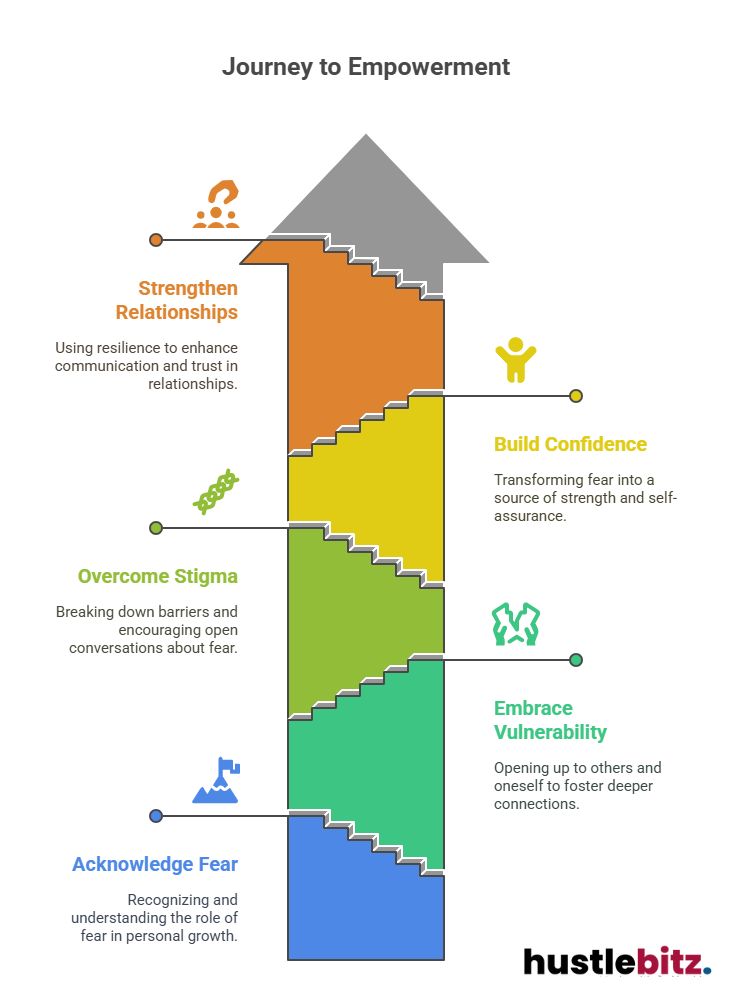Fear, often viewed negatively, holds significant potential for personal growth and strength through vulnerability. It triggers essential biological responses that can catalyze transformation when acknowledged and faced. By embracing vulnerability, individuals foster resilience, allowing for deeper connections and enhanced self-awareness. This process not only aids in overcoming the stigma surrounding fear but also drives motivation and creativity. Learning to transform fear into empowerment equips individuals with the emotional intelligence necessary for navigating challenges and pursuing their goals. Through this journey, one can unlock their true potential, hinting at further insights waiting to be explored.
Key Takeaways
- Fear serves as a catalyst for personal growth, encouraging individuals to acknowledge, act, and reflect on their experiences.
- Embracing vulnerability fosters authentic connections and enhances emotional resilience, leading to deeper self-awareness.
- Overcoming the stigma of fear promotes emotional literacy, encouraging open conversations about shared experiences and fostering compassion.
- Transforming fear into empowerment builds confidence, clarifies personal purpose, and motivates individuals to pursue their goals.
- Resilience developed from facing fears strengthens relationships, improves communication, and builds trust through shared vulnerability.

Understanding the Nature of Fear
At its core, fear is a fundamental human emotion that can serve both as a protective mechanism and a barrier to personal growth. Fear psychology reveals that this emotion arises from complex biological responses, primarily triggered by perceived threats. The amygdala, a key brain structure, plays a crucial role in processing fear, leading to immediate physiological reactions such as increased heart rate and heightened alertness. These biological responses are essential for survival, preparing individuals to respond to danger effectively.
However, fear is not solely a product of biology; it is also shaped by cultural perceptions. Different societies may interpret and express fear in varied ways, influencing how individuals manage their emotions. Cultural context can dictate what is deemed fearful, impacting personal experiences and responses to fear. Understanding these dynamics is vital for effective fear management, as it allows individuals to contextualize their fears and develop strategies to cope with them.
Building emotional resilience is a fundamental aspect of navigating fear. By acknowledging and confronting fears rather than avoiding them, individuals can cultivate a stronger sense of self-efficacy. Emotional resilience enables people to adapt and thrive in the face of challenges, transforming fear from a debilitating force into a catalyst for growth.
Ultimately, a nuanced understanding of fear—encompassing its psychological, biological, and cultural dimensions—can empower individuals to harness its potential for positive change in their lives.
The Connection Between Fear and Growth
Fear often serves as a pivotal catalyst for personal growth, propelling individuals to confront challenges and expand their capabilities. Engaging with our fearful experiences is often a prerequisite for personal transformation. When we face our fears, we cultivate a growth mindset that encourages resilience building and prepares us for future uncertainties.
The process of confronting fear can be broken down into three key stages: acknowledgment, action, and reflection. The following table illustrates these stages and their respective impacts on personal growth:
| Stage | Impact on Personal Growth |
| Acknowledgment | Recognizing and understanding fear creates awareness and opens pathways to growth. |
| Action | Taking steps despite fear fosters resilience and builds confidence in one’s capabilities. |
| Reflection | Evaluating experiences of fear and growth allows for deeper insights and prepares for future challenges. |
Embracing Vulnerability as Strength

Vulnerability, often perceived as a weakness, can actually serve as a powerful foundation for authentic connections and personal empowerment.
Embracing vulnerability acceptance allows individuals to acknowledge their feelings and experiences, fostering an environment where they can express their true selves. This practice of courageous authenticity not only enhances self-awareness but also promotes emotional resilience, enabling individuals to navigate life’s challenges with greater ease.
Personal storytelling plays a pivotal role in this journey, as sharing one’s experiences can cultivate relational intimacy. When individuals open up about their struggles and triumphs, they invite others to do the same, creating a reciprocal atmosphere of trust and understanding. This connection can lead to deeper relationships, as people feel validated and supported in their vulnerabilities.
Moreover, embracing vulnerability does not equate to weakness; rather, it showcases strength. The willingness to be open about one’s fears, pain, and uncertainties demonstrates a profound level of courage. This authenticity can inspire others to confront their own vulnerabilities, ultimately transforming fear into a shared experience that unites rather than divides.
Overcoming the Stigma of Fear

Acknowledging and addressing the stigma surrounding fear is essential for fostering a culture that values openness and emotional honesty. Fear is often perceived negatively, leading to a fear stigma that discourages individuals from expressing their vulnerabilities. This stigma is entrenched in societal perceptions that equate fear with weakness, fostering cultural attitudes that prioritize stoicism over emotional resilience.
To combat this, we must encourage personal narratives that highlight the universality of fear as a human experience. Sharing stories of overcoming fear can help dismantle the barriers that prevent individuals from openly discussing their emotions. By framing fear as a natural response rather than a personal failing, we can begin to shift cultural attitudes towards a more compassionate understanding of emotional struggles.
Educational initiatives that promote emotional literacy can also play a significant role in reducing fear stigma. By teaching individuals how to recognize, articulate, and manage their fears, we empower them to cultivate emotional resilience. This not only benefits the individual but also enhances community connections, as shared experiences of fear can foster empathy and support among peers.
Ultimately, overcoming the stigma of fear requires a collective effort to redefine our perceptions of vulnerability. By encouraging dialogue and embracing the complexity of human emotions, we can create an environment where fear is acknowledged as a stepping stone to growth rather than a source of shame. This cultural shift is vital for nurturing emotional well-being and resilience in our increasingly complex world.
Fear as a Catalyst for Change

Harnessing the power of fear can serve as a transformative force, driving individuals to confront challenges and enact meaningful change in their lives and communities. When approached with the right mindset, fear can act as a catalyst for personal growth and societal advancement. This dynamic often reveals the dual nature of fear—both a daunting presence and a source of motivation.
Fear’s motivational role is particularly salient in decision making. It encourages individuals to assess risks and weigh potential outcomes, fostering a culture of strategic thinking. Additionally, fear-driven innovation emerges when individuals use their apprehensions to fuel creativity, leading to unique solutions and breakthroughs. By acknowledging fear as opportunity, individuals can navigate their uncertainties and channel them into productive avenues.
Key aspects of fear as a catalyst for change include:
- Fear-Driven Innovation: Embracing challenges can lead to novel ideas and advancements.
- Fear’s Motivational Role: Fear can push individuals to act, rather than remain stagnant.
- Fear in Decision Making: Acknowledging fear can lead to more informed and deliberate choices.
- Fear and Creativity: Confronting fear can unlock creative potential and inspire new perspectives.
Transforming Fear Into Empowerment

Empowerment emerges when individuals confront their fears, transforming them from obstacles into opportunities for growth and self-discovery. This process begins with effective fear management, which involves recognizing and understanding one’s fears rather than avoiding them. By actively engaging with fear, individuals can cultivate emotional intelligence, allowing them to respond thoughtfully rather than react impulsively in challenging situations.
As individuals embark on this journey of transformation, they often find that risk-taking becomes a vital component of personal development. Embracing calculated risks can lead to resilience building, as each experience provides valuable lessons that foster adaptability and strength. This resilience not only enhances one’s ability to navigate future challenges but also reinforces a sense of self-efficacy and empowerment.
Moreover, confronting fear can trigger significant personal transformation. Individuals who learn to face their fears often discover new aspects of themselves, unlocking potential they may have previously underestimated. This newfound awareness can lead to healthier relationships, increased confidence, and a more profound sense of purpose.
Final Thoughts
Embracing fear as a source of strength and vulnerability allows individuals to unlock personal growth and deepen emotional resilience. By acknowledging fear and understanding its role in driving change, individuals can transform it from an obstacle into an opportunity for empowerment. Through practices like vulnerability acceptance, fear management, and the cultivation of authentic connections, fear becomes a tool for personal transformation and meaningful relationships. Ultimately, the journey of facing fear strengthens emotional intelligence, creativity, and resilience, leading to a more fulfilling and empowered life.




